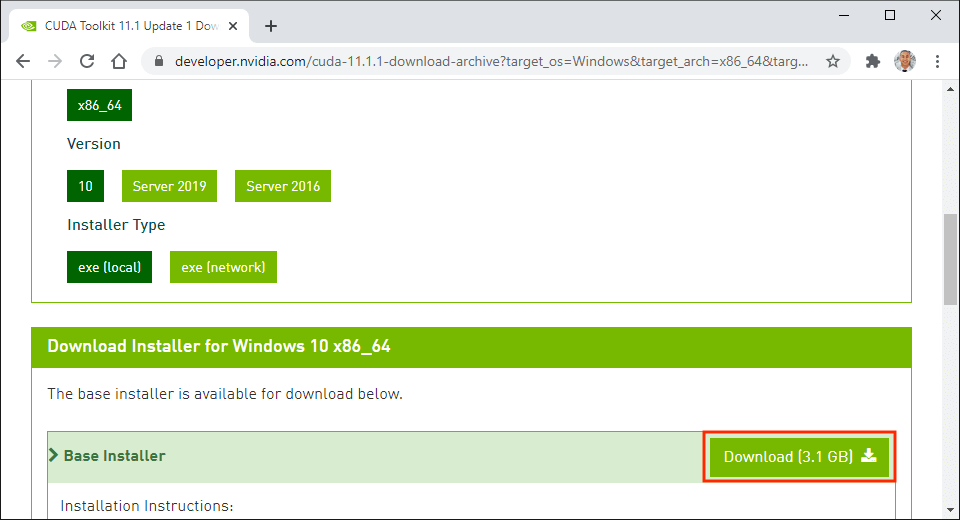

- #Cuda driver windows 10 install
- #Cuda driver windows 10 drivers
- #Cuda driver windows 10 code
- #Cuda driver windows 10 download
Join us for DockerCon2022 on Tuesday, May 10.

#Cuda driver windows 10 download
#Cuda driver windows 10 code
With Docker Desktop, developers can run their code locally and deploy to the infrastructure of their choice.She described a tensorflow example and deployed it in the cloud: Conclusion: What are the benefits for developers?Īt Docker, we want to provide a turn key solution for developers to execute their workflows seamlessly: I will simply point you to Anca’s blog earlier this year. The tensorflow:latest-gpu image can take advantage of the GPU in Docker Desktop. Well really, looking at GPU usage without looking at machine learning would be a miss. Here’s an example image: Machine learning It’s not possible to add GPU intensive steps during the build. Note that the -gpus=all is only available to the run command.

$ docker run -gpus=all -ti -rm -v $:/tmp/ cudafractal. RUN sed 's/4736/1024/' -i fractal_cuda.cu # Make the generated image smallerĪnd then we can build and run: $ docker build.
#Cuda driver windows 10 install
RUN DEBIAN_FRONTEND=noninteractive apt -yq install git nano libtiff-dev cuda-toolkit-11-4 A simple Dockerfile with nothing fancy helps for that. Let’s see if we can have it running on Docker Desktop. There are two steps to build and run on Linux. The project at uses CUDA for generating fractals. Name.: NVIDIA GeForce GTX 1650 Tiįrom there it is possible to run hashcat benchmark hashcat -b Hashcat (v6.2.3) starting in backend information modeĬlGetPlatformIDs(): CL_PLATFORM_NOT_FOUND_KHR This image magically works on Docker Desktop! $ docker run -it -gpus=all -rm dizcza/docker-hashcat hashcat -I dizcza hosted its nvidia-docker based images of hashcat on Docker hub. Using a GPU is of course useful when operations can be heavily parallelized. = 1.042 single-precision GFLOP/s at 20 flops per interaction What can you do with a paravirtualized GPU? Run cryptographic tools GPU is 2000 times faster: > Simulation with CPUĤ096 bodies, total time for 10 iterations: 3221.642 ms Quick comparison to a CPU suggest a different order of magnitude of performance. = 2068.205 single-precision GFLOP/s at 20 flops per interaction = 103.410 billion interactions per second > Compute 7.5 CUDA device: ġ6384 bodies, total time for 10 iterations: 25.958 ms GPU Device 0: "Turing" with compute capability 7.5 $ docker run -it -gpus=all -rm nvcr.io/nvidia/k8s/cuda-sample:nbody nbody -benchmark The nbody utility is a CUDA sample that provides a benchmarking mode. # gpu pwr gtemp mtemp sm mem enc dec mclk pclk

The dmon function of nvidia-smi allows monitoring the GPU parameters : $ docker exec -ti $(docker ps -ql) nvidia-smi dmon | GPU GI CI PID Type Process name GPU Memory | | Fan Temp Perf Pwr:Usage/Cap| Memory-Usage | GPU-Util Compute M. | GPU Name Persistence-M| Bus-Id Disp.A | Volatile Uncorr. $ docker run -it -gpus=all -rm nvidia/cuda:11.4.2-base-ubuntu20.04 nvidia-smi The nvidia-smi utility allows users to query information on the accessible devices. Where to find the Docker imagesīase Docker images are hosted at. Nvidia used the term near-native to describe the performance to be expected.
#Cuda driver windows 10 drivers


 0 kommentar(er)
0 kommentar(er)
